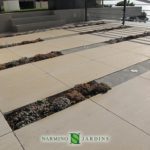In addition to the originality and beauty of the green roof, this option is an excellent way to shield a house or building from temperature changes. In the city, residences with green roofs reduce CO2 emissions as well as the feeling of suffocation one often experiences in cities. The vegetation captures saturated and polluted air (trapping dust particles), brings a feeling of freshness and purity to the air, and encourages a lowered temperature, especially in the summer. Green roofs also reinforce sound barriers and help to drain rainwater (partly through absorption and partly through recuperation).
Below are some projects completed for clients on the Côte d’Azur, between Nice and Monaco:
What do green roofs do?
A green roof is a roof covered with a roof-terrace or a penthouse covered with vegetation, which brings visible beauty to the surface as well as multiple practical advantages. We see them more and more in our urban environment, and this landscape technique is a trend on its way to becoming a permanent fixture in theories of urban design and contemporary architecture. It is not, however, a new technology: green roofs have apparently existed since the Neolithic Age and ancient and traditional techniques are still practiced in certain areas of the world, such as Northern Europe.
Today the greening of rooftops responds to various needs, including that of bringing more Nature and eco-friendliness into cities, which populations are increasingly demanding. Moreover, if these roofs are implemented and cared for properly, according to the standards of reputable companies and recognized landscape architects, their beauty offers obvious added-value to both passers-by and residents. These features also encourage biodiversity by allowing fauna, flora, and insects to create inviting ecosystems within the city. The thermal insulation and substantial energy savings of these structures is widely acknowledged. Green roofs also offer well-documented acoustic improvements.
The green roof’s structural elements ensure its proper functioning. These include the supporting structure (generally constituted by a concrete roof), the waterproofing layer whose importance is obvious, a drainage layer that also gives the green roof a filtering effect, and a substrate that allows the plants to grow in good conditions. Certain plants will be more adapted to this type of structure, including flowering plants, aromatics, grasses, some green plants, and possibly some cacti.
Narmino Jardins will carry out all the steps in the production of your green roof, from assessment all the way to the final product, by calling upon all the different professionals necessary for your project (architect, landscaper, masonry company, etc….). To request our advice please go to this page.

